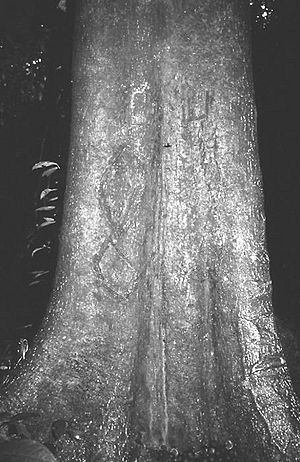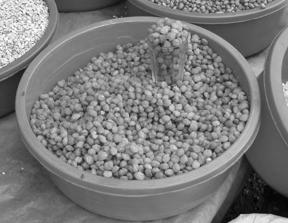Ricinodendron facts for kids
Quick facts for kids Ricinodendron |
|
|---|---|
 |
|
| Conservation status | |
| Scientific classification | |
| Genus: |
Ricinodendron
|
| Species: |
heudelotii
|
| Subspecies and varieties | |
| Synonyms | |
Ricinodendron heudelotii subsp. heudelotii |
|
The Njangsa tree, also known as Ricinodendron heudelotii, is a special plant found in tropical Africa. It's the only known species in its plant genus, Ricinodendron. Scientists first described this genus in 1864.
Njangsa trees are important because they produce seeds that are used for oil and as a spice. People in different African countries have many names for this tree. For example, it's called munguella in Angola, njangsa in Cameroon, wama in Ghana, and okhuen in Nigeria. You might also hear it called akpi in Ivory Coast, or djansang, essang, ezezang, and njasang.
Contents
What is Njangsa?
Njangsa is a tall, fast-growing tree that can reach heights of 20 to 50 meters (about 65 to 164 feet). Its trunk can be very wide, up to 2.7 meters (nearly 9 feet) across! The tree has a wide top, called a crown, and large roots that spread out. Its bark is smooth and grey, but if you cut it, the inside looks red.
How Njangsa Flowers and Fruits
Njangsa is a dioecious plant. This means it has separate male and female trees. The flowers are small, yellowish-white, and grow in long clusters. They usually bloom between April and May. Male flower clusters are typically larger and thinner than female ones.
The fruits of the Njangsa tree usually have two or three sections, each holding seeds. These seeds are round, about 1 centimeter (0.4 inches) wide, and range from reddish-brown to black. They feel oily and can be bought either fresh or dried. When ripe, in August or September, the fruit smells a bit like very ripe apples. The seeds themselves have a unique, slightly bitter taste with a hint of chocolate.
Where Njangsa Grows
Njangsa trees are native to tropical Africa. You can find them across a wide area, from Senegal in West Africa all the way to Sudan, Uganda, and Tanzania in the east. They also grow south along the western coast to Angola. Some Njangsa trees are even found on the island of Madagascar.
These trees mostly grow in rainforests. They are also common in secondary forests, which are forests that have regrown after being cleared. Njangsa needs a lot of light, so it can also be found at the edges of forests, in deciduous forests (where trees lose their leaves), and in bushy areas within semi-dry savannahs. Farmers often keep Njangsa trees in their fields, like cocoa farms, because the trees are so useful.
Uses and Benefits of Njangsa
Njangsa trees offer many benefits, from food to medicine and even helping the environment.
Njangsa as Food
The most valuable part of the Njangsa plant for food is its kernel, which is inside the seed. These kernels are packed with nutrients. In West and Central Africa, dried and ground kernels are used to add flavor to many dishes. The ground kernel paste can also make soups and stews thicker.
You can also get oil from the kernels. This oil is yellowish and tastes a bit like groundnut oil. It's very stable and doesn't go bad quickly because it contains a lot of a special nutrient called gamma-tocopherol. This makes Njangsa oil good for cooking and even for making margarine.
| What's in it | How much (%) |
|---|---|
| Water | 3.1 +/- 0.8 |
| Fatty acid | 47.4-55.30 |
| Crude protein | 24.3-65.2 |
| Total carbohydrates | 5.6-9.3 |
| Digestible carbohydrates | 5.6-9.3 |
| Crude fibres | 8.9-9.3 |
| Ash | 10.5-17.8 |
| Nitrogen | 8.6 +/- 0.9 |
| Dry extracts | 97.8 |
| pH | 7.84 |
| Energy value | 495 kcal/100g |
What Njangsa Seeds Are Made Of
How Njangsa is Used in Cooking
People usually dry Njangsa seeds to use them as a spice. The whole seeds are often pounded in a pestle and mortar to make a paste. This paste is then added to soups and stews to make them thicker. Sometimes, the crumbled spice is sprinkled over rice for extra flavor. You can also find the spice from Njangsa seeds sold in African markets, often shaped like small sausages.
Njangsa for Health
Traditional healers use extracts from the Njangsa tree's bark. They believe it can act as an antidote to certain poisons because it contains a substance called lupeol. The tree is also used to help treat various illnesses like coughs, malaria, yellow fever, stomach pain, and rheumatism. It's also known for its anti-inflammatory properties, which means it can help reduce swelling. Parts like the seed husk, latex, and leaf extracts are also used in traditional medicine.
Njangsa and the Environment
Njangsa trees help improve the soil quality. Their roots are home to helpful fungi called mycorrhizae, and their fallen leaves add nutrients to the ground. When the kernel shells are burned, they produce ash rich in potassium, which is good for plants. The leftover material after oil is taken from the seeds is high in nitrogen, making it another useful fertilizer. Njangsa trees also provide shade for people, animals, and crops. During dry seasons, their leaves can even be used as food for livestock.
Other Uses for Njangsa
The oil from dried Njangsa kernels and the ash from burning them can be used to make soap and varnish.
Njangsa in Culture and Games
In southern Cameroon, dried Njangsa seeds are used in a traditional game called songho. In Sierra Leone, they are used to make rattles for bundu dances. In Nigeria, the seeds are part of a game called okwe.
Growing Njangsa Trees
Where Njangsa is Grown
The main area where Njangsa is grown is in the humid forests of Cameroon. It's very common to see young Njangsa trees growing in open parts of the forest. When farmers clear land for new farms, they often choose to keep Njangsa trees because they are so valuable.
How Much Njangsa is Produced?
The kernel is the most important part of the tree for money. People collect the kernels from the ground between September and October. Njangsa trees usually produce fruit every two to three years, but some trees produce them more often. Each harvest can yield up to 900 fruits, which means about 72 kilograms (158 pounds) of kernels on average.
Growing Conditions for Njangsa
| Weather Conditions | Lowest | Highest |
|---|---|---|
| Altitude (meters) | 100 | 1250 |
| Rainfall (mm) | 1000 | <3000 |
| Temperature (°C) | 18 | 32 |
What Njangsa Needs from the Climate
| Soil Features | Best Place to Grow |
|---|---|
| Soil type (texture) | Medium textured ultisols and oxisols |
| Topography | Lowlands |
| Rooting depth | Drains easily |
| Soil pH | Acidic, pH 5-6 |
What Njangsa Needs from the Soil
Njangsa seeds grow best when planted in a mix of river sand and forest soil, with three parts forest soil to one part sand.
How to Plant Njangsa
Starting New Njangsa Plants
You can grow Njangsa from seeds, by vegetative propagation (using parts of the plant like cuttings), or by grafting.
Growing from seeds helps the tree develop a strong main root, which makes the tree stable and helps it find water and nutrients. However, since Njangsa has separate male and female trees, it's hard to tell them apart before they flower. Also, seeds can produce trees with slightly different traits from the parent plant.
Vegetative propagation is a way to make new trees that are exactly like the female tree you want to copy. Grafting involves joining a shoot or bud from one Njangsa tree onto the root system of another already growing tree.
Setting Up the Field
First, the area where you want to plant should be cleared, especially if you're growing other crops there. Then, young Njangsa plants can be planted in holes about 10 meters (33 feet) apart.
Before planting them in the field, the young plants need to grow under shade for at least six months and be at least 20–30 centimeters (8–12 inches) tall. After planting, it's good to build a 1-meter (3-foot) high fence of palm leaves around them for shade during the first two weeks.
Caring for Njangsa Plants
Water: After planting, the young Njangsa plants need lots of water to help them get used to their new home. Putting a layer of mulch (like leaves or straw) on the soil can help keep the soil moist and prevent water from evaporating too quickly.
Fertilizer: Njangsa grows fast, so giving it enough nutrients through mineral fertilizer can help it grow and develop even better.
Weeding: When the plants are young, it's very important to remove weeds. Weeds compete for water and nutrients, so removing them helps the Njangsa grow quickly and strongly.
Pests and Diseases: So far, no major diseases have been seen affecting Njangsa. However, it can be attacked by plant-eating caterpillars (like Lobobunaea phaedusa and Imbrasia petiveri). These caterpillars are actually edible, so instead of using chemicals, people often collect them as a source of food protein! Aphids can sometimes infest young plants in nurseries. You can spot them because the leaves will curl. These aphids can be controlled with a special systemic insecticide. Once the trees are more than two years old in the field, they usually become strong enough that treatments are no longer needed.
Harvesting and Storing Njangsa
Njangsa trees in forests start producing fruit after 6 to 7 years. In managed plantations, they can start producing fruit earlier, after 3 to 4 years. The fruits are picked by hand from the ground once they are ripe enough to fall from the tree, usually in September and October. To make harvesting easier, the ground under the tree should be cleared. After picking, the fruits are piled up for two to three weeks. This helps the fruit pulp rot faster, making it easier to get the seeds out.
Getting the kernel out of the hard seed is a process that takes time. After boiling the seeds in water and letting them cool, the kernels are carefully removed one by one using a knife or fingernails. Then, the kernels are dried in the sun or over a fire. Njangsa can be stored as whole seeds or as kernels. If they are dried well, they can be kept in a dry place for up to two years.
Images for kids




